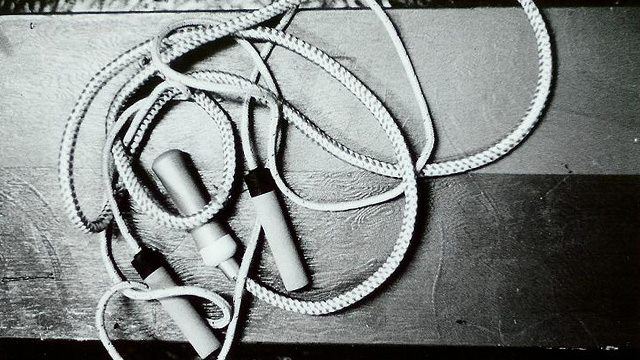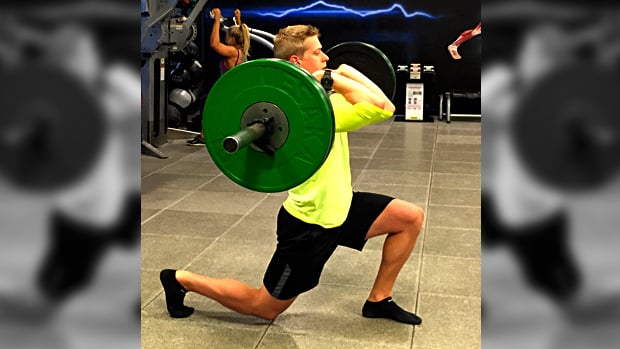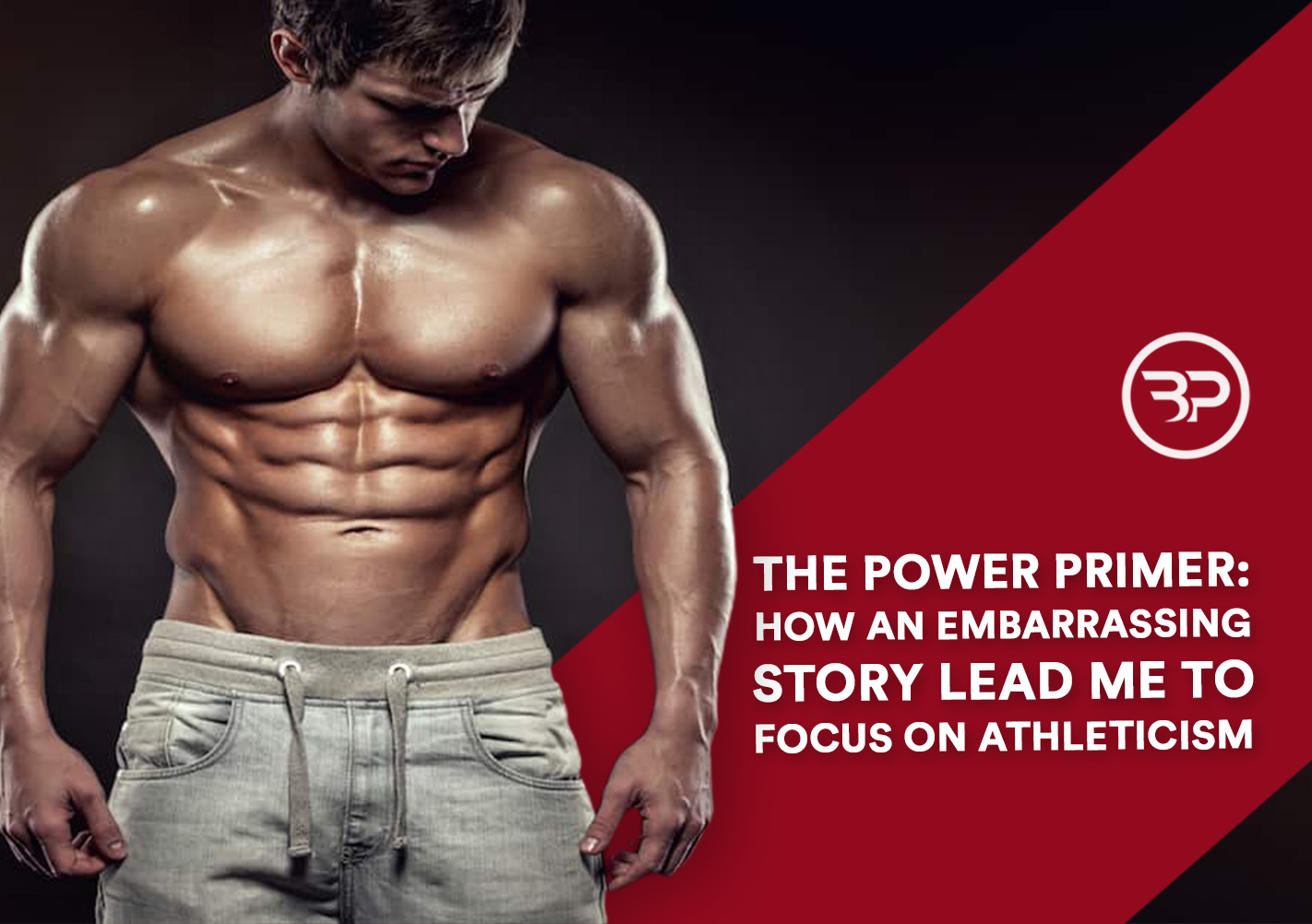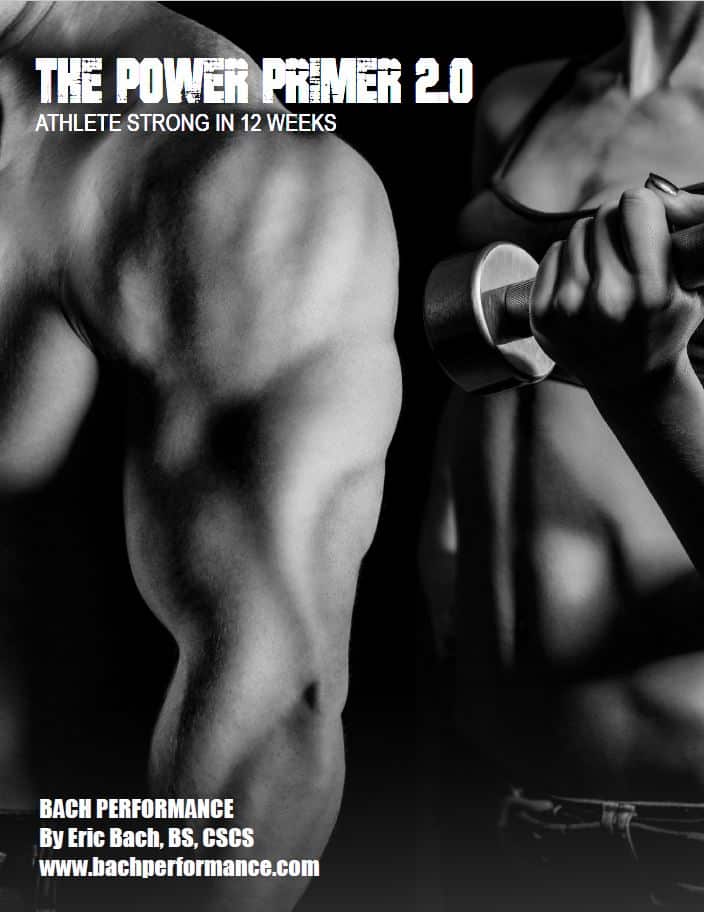The Power Primer: How an Embarrassing Story lead me to focus on Athleticism
April 4, 2016
As a kid athleticism was never an issue. I played a ton of sports, ran around the neighborhood making forts and playing pick-up games.
But, I was small and weak. Puny even. Especially compared to my classmates.
As a result, I was timed. I lacked confidence in how I looked, and how I performed playing sports.
This built up until at all once, it came to head. It was high school gym class in late October. In Wisconsin, the frigid temperatures meant the ground was rock solid. Every time you hit the ground, it felt like falling on a pile of rocks.
We were playing flag Football…where the idea is to pull a flag rather than tackle each other into oblivion. Well, that’s the idea.
Being a smaller, fast dude I was playing safety. My job was to run anyone down who might score.
The other team lined up and through the ball to Jason. Jason was the token overdeveloped, terminator-like dude who dominated every sport and got the hottest chicks in school. He caught it and sprinted in my direction.
Soon, I was in the last place a puny unconfident dude wanted to be: between Jason and the end zone.
Jason had two options; race past me, or run through me.
Naturally, Jason decided I provided less resistance than a blade of grass. So he lowered his shoulder and sent my helpless corpse tumbling to the turf as he gliding to the end zone.
I looked up at the overcast sky. I heard the jeers. And then I lay there, motionless for a moment.
Physically, I was a mess.
My body lost cabin pressure, with my wind being ripped out of my lungs. I’d taken a punch to the gut before, but this felt like a body shot from Connor McGregor and I crumbled to the turf like a ragdoll.
I felt weak.
I felt pathetic.
I felt worthless.
I peeled my carcass off the grass, stumbled to a knee, and caught my breath.
As I stumbled to the sidelines, chin down and arm cradled at my side, the jeers and taunts grew louder.
I walked away from everyone: friends, teachers, and classmates.
I stood there, staring blankly into nowhere. I just wanted to be alone.
The skin on my cheeks tightened and my eyes got big. I held back tears of embarrassment. But my cheeks blushed, illustrating exactly how I felt inside.
Fuck it.
Why was I even bothering with working out?
Then, I snapped out of it. Instead of moping around and feeling sorry for myself, I got pissed.
Pride, passion, perseverance.
I heard the voice of an old coach saying these words. Whenever a game got tough, that was his credo.
That did it. It was a turning point. Why let some asshole like Jason ruin me?
From there on, I dedicated myself to training.
To building strength, muscle, and confidence. To forge a body and will harder than iron. To build a body that improved my life, rather than consumed it.
Fast forward eight years, eighty pounds and a ton of enhanced confidence later, I was a coach.
Helping busy men and athletes alike get strong, lean, and powerful became my obsession.
And then it happened.
I was at a seminar, working with other trainers and a handful of coaches on sprint technique.
Problem was, I hadn’t done much in the way of sprinting, jumping, or sports in a few years.
Competitive and intramurals sports were over. Now, I relegated my fitness to lifting heavy shit and the bi-monthly “cardio.”
We all stood in a line, facing the instructor, and began a skipping drill.
I tried my best to mimic the drill he covered but to no avail. I skipped awkwardly, like a drunk baby giraffe.
Bewildered by my lack of coordination, I lost focused and stumbled over my own feet.
What the heck was I doing?
Rather than the athleticism I’d had my whole life, I looked like a convulsing teenager who had just seen his first side boob.
The same crushing embarrassment took hold. My skin flushed. This time, I cracked a joke. It was my new coping mechanism. But I wasn’t really fooling anyone, least of all myself.
Despite a fake smile and a few jokes, my gut wrench the same way it does after Montezuma’s revenge, without the aftermath. I stood there, embarrassed and dumbfounded.
Sure, I was strong, lean, and pretty built. But where had all l my athleticism gone?
Further, I asked what’s the point in all this heavy lifting, counting macros, and dedication if we ignore the basic idea of being strong, healthy, and athletic?
That’s the problem I’d set out to fix.
First for myself, and then for hundreds of clients who wanted to be the total package: strong, lean, athletic and most of all, have a body that improves their life.
Today, more than ever, many of us are weak. Many kids drop out of sports by age 12.
Overprotective parents don’t help and participation trophies don’t help.
Neither do sedentary desk jobs.
And despite the increasing popularity of fitness, actual sports and athleticism are quickly going down the shitter, as is our health and worst of all, our confidence.
The result?
We’re fatty, weaker, and in worse health than ever before. According to the Center for Disease Control (CDC), 36% of the U.S. population is obese, and 70% are overweight, increasing the risk for everything from cancer and heart disease to diabetes.
Physically, men today are 17% weaker than their fathers one generation earlier when looking at grip strength.
Physiologically speaking, research has shown an average drop in testosterone levels of 22% since 1987; meaning the hormone that determines the male gender is a fraction of what it used to be.
A fair number of strong and lean bodies, but piss-poor athleticism and power.
To steal from Nate Green’s masterful rant titled “For the Guys who Don’t Workout.”
“But you gotta understand the gym doesn’t define me. I am not my broad shoulders. I am not my six-pack. I am not my freakin’ biceps.”
Sure, your broad shoulders, six-pack, and biceps are great. But you deserve more.
You deserve a capable body and the unconquerable will that comes with building athleticism and powerful performance. Most of all, you deserve the confidence to stand in front of the mirror, at the beach, in front of your friends and colleagues and be proud of your body.
And that means changing your training to incorporate values of athleticism, namely, explosive power.
After working with hundreds of clients, I’ve found that adding in explosive power to be the best method for getting what we all want: a strong, lean, and athletic body.
I’ve handcrafted the perfect workout to take your physique to the next level without beating up your joints or forcing you to do soul-sucking cardio.
Here’s a sneak-peek of the top five exercises to build strength, explosive power, and the ultimate athletic physique.
5 Power Primer Exercises to Build Athleticism
Jump Rope
Jump ropes aren’t a stupid tool you force-fed in Elementary school. They’re a badass old-school tool that boosts athleticism and shreds bodyfat.
Let’s dive into boosting athleticism first.
Jumping rope develops speed, agility, and coordination for sports. Sprinting is great too ( and I’ll cover it later), but for dudes who haven’t run around the block in five years, jumping into full-speed sprints is asking for injuries.
You wouldn’t jump into near-maximal lifting after a long layoff, would you?
Nah. You’re smarter than that.
The same philosophy applies to sprints. You must first condition your joints and ligaments, especially the Achilles tendon, for high-speed impact.
Even better, the jump rope is a one of the safest conditioning tools for two reasons:
First, jumping rope is a self-limiting exercise, meaning that when your form breaks down the exercise ends.
To be successful skippin’ the ole’ rope, you’re forced to stay in an aligned, joint stacked position, stabilizing your core under the load of movement.

This teaches your core to hold position under movement while preventing the chances of overuse.
Second, jumping rope is low-impact despite a high number of foot strikes. This keeps the joint stress low and conditions the Achilles tendon for explosive movement. Achilles tendon injuries are alarmingly common in weekend warriors.
The jump rope provides one of the best prevention tools around. It is exceptionally effective both as a low impact athleticism and conditioning tool. For most, jumping rope two or three times per week for 10-15 minutes provides a huge boost.
Squat Jump
The squat jump is one of the best exercises to improve your power and get more athletic, especially if your gym doesn’t allow Olympic lifts. Squat jumps mimic the squat and a vertical jump, bridging the gap between jumping in sport and squatting in the gym.
In the short term, these explosive exercises improve your workouts by activating high-threshold motor units to fire and recruit more muscle during training. This means you’ll be able to lift more weight and stimulate more muscle growth and strength during workouts.
In the long-term, you’ll recruit more muscle fibers with less effort.
This makes it easier to call all more muscle to action and smash heavy weights, thus helping you build a strong, lean, and explosive body.
How to do it: There are three phases: loading, exploding, and landing.
Loading: Set up with feet about shoulder-width apart in an athletic stance with arms up at chest height. The loading phase uses downward arm swing with flexing at the hips and knees to load your legs.
Exploding: Swing your arms up while extending your hips and knees, taking off on the balls of your feet. Extend the arms overhead and aim to extend the body with the ankle, knee, hip, trunk, shoulder, and ear all aligned.
Landing: Bend your knees into a squat position and absorb force evenly through the foot. Keep your chest and head up, looking straight ahead.
How many: Three sets of five reps with 60-90 seconds rest. Perform on a lower-body training day, before a squat or deadlift.
Hill Sprints
Sprinters have some of the world’s best bodies. And while correlation does not equal causation, sprinting is a basic skill in sports and gets you shredded.
So what’s the key?
Sprints create a physiological response like high-intensity weight lifting.
In sprinting, your glutes, hamstrings, quads, calves, and hips generate insane amounts of force while your spine stabilizes and transfers power.
This builds stronger legs and youthful athleticism while triggering a massive hormonal shift in your body.
Three hormones that help you look better naked are affected by sprints:
Testosterone – The major masculinizing hormone in your body. Greater testosterone levels improve your energy, improve sex drive (wee!), build stacks of lean mass, and cut body fat.
Growth Hormone (GH) – GH is released in response to large muscle contractions and is further stimulated by training without full recovery.
Triggered by metabolic stress, the stressful environment when you’re gasping for air and muscles are on fire, GH is referred to as the fountain of youth. GH slows the aging process, aid in fatty acid metabolism, and boost protein synthesis.
Improved Insulin Sensitivity – Huge muscular contractions stimulate improved insulin sensitivity, which improves markers of cardiovascular health, builds lean muscle, and carves body fat off your body.
Further, improved insulin sensitivity improves nutrient partitioning. That means your body improves at breaking down nutrients for energy and muscular recovery rather than fat storage.
What to Do: Hill or incline sprints are best as they reduce injury risk. The hill makes it mechanically impossible to over stride, decreasing the risk of the dreaded hamstring pull.
Further, running up a hill shrinks the distance your foot covers to the ground, decreasing joint stress.Sprint twice per week, as an individual workout or after a lift.
After a warm-up, sprint all out for eight – twelve rounds of sprints.
Here’s a sample six-week progression:
Weeks One and Two: Sprint 15 seconds, rest 45 seconds
Weeks Three and Four: Sprint 20 seconds, rest 40 seconds
Weeks Five and Six: Sprint 25 seconds, rest 35 seconds
High Pull
I love cleans, but for a lot of lifters, years of heavy loading and poor thoracic mobility make it impossible to catch the bar with the elbows up. Enter the high pull.
The high pull uses explosive hip extension, teaching the glutes, quads, and hamstrings to generate insane amounts of force while your core stabilizes your spine and elbows drive the bar up.
As a result, the high pull helps you develop explosive athletic power and builds a jacked and athletic body. After a few weeks of high pulls, you’ll notice thicker glutes and hamstrings to pair with thick traps and cables for forearms.
High pulls are great on both upper and lower body days. Since they’re explosive in nature, make high-pulls the first exercise you do in training to get more athletic with sets and reps like 3-4 sets of 3-6 reps.If you want to add a bit more size, add them after your main lift for 4-5 sets of 6-8 reps.
Clean Grip Reverse Lunge
Most lifters have tight hips, achy knees, a weak upper back, underactive abs and tons of asymmetries between their legs. If I told you I had an exercise that takes care of all these ailments and makes you more athletic and resistance to injury, you’d say I was full of shit, right?
Well, I’m not. The clean grip reverse lunge is that exercise.

Stronger thoracic extensors: Are you hunched over your smartphone reading this?
Tsk, Tsk!
Bad posture is an epidemic and we’re all guilty. To improve posture and shoulder health we need to train the traps, serratus, levator scapulae, rhomboids, and lats to hold position and prevent you from flexing forward. Holding the bar in the clean grip does exactly that.
Less Knee Stress: Holding the barbell on the front of your body limits the weight you can use. That means less joint compression on the knee and spine.
Further, stepping backward keepings your shin vertical, limiting shear stress on the knee. By reducing shear and compressive stress, you’ll keep happier, healthier knees.
Better Abs: Holding the bar on the front of your body forces your entire core to engage, keeping your vertical so you don’t fold like an accordion.
Fix asymmetries: The clean grip reverse lunge requires dynamic stabilization and single leg strength. This works the major muscles in your leg and what’s termed the lateral subsystem, a group of neglected muscles (quadratus lumborum, adductors, and glutes) to stabilize each leg and generate strength.
Medicine Ball back Toss
The medicine ball back toss is one of the best exercises to get more athletic for two reasons:
1. You get to throw stuff.
After a long day, or just for the hell of it, it’s fun to throw heavy stuff around.
2. Explosive Hip Extension.
Explosive hip extension is the driving force behind taking off in a sprint, maximizing your clean, squat, or deadlift, and jumping. Adding a medicine ball is just another way to add explosiveness to the same movement pattern while having a bit more fun.
Instead of squats or deadlifts, add medicine ball back tosses in the beginning of your workout for 3-4 sets of 5-8 reps.
Most lifters fall into the trap of endlessly pursuing one goal at the expense of all other training parameters.
That’s fine for elite athletes. But for the rest of us, we’re after the total package.
There’s no better tool to bridge the gap between the body you want and the athleticism you deserve than my latest program The Power Primer, 2.0.
I’ve created eight months worth of programming to get you Strong, Shredded, and Athletic. This isn’t a program for athletes.
It’s for those of us that refuse to accept pathetic athleticism a the cost of building your best-looking body.
It’s time to bridge the gap between athleticism and aesthetics.
It’s time to unleash the Power Primer and build your leanest, strongest, and most athletic body to date.
For less than you spend on protein powder each month, you’ll have all your workouts expertly planned, organized, and guided by a custom video guide from now until 2017.
Get the Power Primer Today
1. Gould D, Petlichkoff L. Participation motivation and attrition in young athletes. In: Smoll FL, Magill RA, Ash MJ, eds. Children in Sport. 3rd ed. Champaign IL: Human Kinetics; 1988:161-178.










